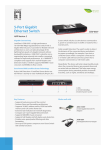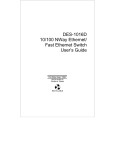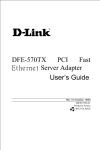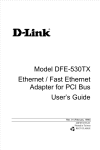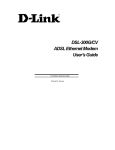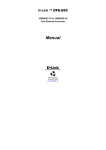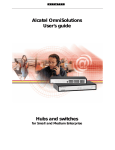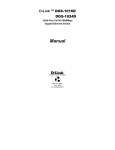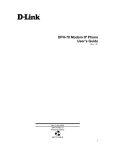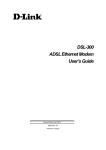Download D-Link DES-810 User's Manual
Transcript
DES-810 DES-818 10/100 Fast Ethernet Switch User’s Guide Rev. 02 (Aug., 1997) 6DES810...02 Printed In Taiwan RECYCLABLE Wichtige Sicherheitshinweise 1. Bitte lesen Sie sich diese Hinweise sorgfältig durch. 2. Heben Sie diese Anleitung für den spätern Gebrauch auf. 3. Vor jedem Reinigen ist das Gerät vom Stromnetz zu trennen. Vervenden Sie keine Flüssig- oder Aerosolreiniger. Am besten dient ein angefeuchtetes Tuch zur Reinigung. 4. Um eine Beschädigung des Gerätes zu vermeiden sollten Sie nur Zubehörteile verwenden, die vom Hersteller zugelassen sind. 5. Das Gerät is vor Feuchtigkeit zu schützen. 6. Bei der Aufstellung des Gerätes ist auf sichern Stand zu achten. Ein Kippen oder Fallen könnte Verletzungen hervorrufen. Verwenden Sie nur sichere Standorte und beachten Sie die Aufstellhinweise des Herstellers. 7. Die Belüftungsöffnungen dienen zur Luftzirkulation die das Gerät vor Überhitzung schützt. Sorgen Sie dafür, daß diese Öffnungen nicht abgedeckt werden. 8. Beachten Sie beim Anschluß an das Stromnetz die Anschlußwerte. 9. Die Netzanschlußsteckdose muß aus Gründen der elektrischen Sicherheit einen Schutzleiterkontakt haben. 10. Verlegen Sie die Netzanschlußleitung so, daß niemand darüber fallen kann. Es sollete auch nichts auf der Leitung abgestellt werden. 11. Alle Hinweise und Warnungen die sich am Geräten befinden sind zu beachten. 12. Wird das Gerät über einen längeren Zeitraum nicht benutzt, sollten Sie es vom Stromnetz trennen. Somit wird im Falle einer Überspannung eine Beschädigung vermieden. 13. Durch die Lüftungsöffnungen dürfen niemals Gegenstände oder Flüssigkeiten in das Gerät gelangen. Dies könnte einen Brand bzw. Elektrischen Schlag auslösen. 14. Öffnen Sie niemals das Gerät. Das Gerät darf aus Gründen der elektrischen Sicherheit nur von authorisiertem Servicepersonal geöffnet werden. 15. Wenn folgende Situationen auftreten ist das Gerät vom Stromnetz zu trennen und von einer qualifizierten Servicestelle zu überprüfen: a– Netzkabel oder Netzstecker sint beschädigt. b– Flüssigkeit ist in das Gerät eingedrungen. c– Das Gerät war Feuchtigkeit ausgesetzt. d– Wenn das Gerät nicht der Bedienungsanleitung ensprechend funktioniert oder Sie mit Hilfe dieser Anleitung keine Verbesserung erzielen. e– Das Gerät ist gefallen und/oder das Gehäuse ist beschädigt. f– Wenn das Gerät deutliche Anzeichen eines Defektes aufweist. 16. Bei Reparaturen dürfen nur Orginalersatzteile bzw. den Orginalteilen entsprechende Teile verwendet werden. Der Einsatz von ungeeigneten Ersatzteilen kann eine weitere Beschädigung hervorrufen. 17. Wenden Sie sich mit allen Fragen die Service und Repartur betreffen an Ihren Servicepartner. Somit stellen Sie die Betriebssicherheit des Gerätes sicher. WARRANTIES EXCLUSIVE IF THE D-LINK PRODUCT DOES NOT OPERATE AS WARRANTED ABOVE, THE CUSTOMER'S SOLE REMEDY SHALL BE, AT D-LINK'S OPTION, REPAIR OR REPLACEMENT. THE FOREGOING WARRANTIES AND REMEDIES ARE EXCLUSIVE AND ARE IN LIEU OF ALL OTHER WARRANTIES, EXPRESSED OR IMPLIED, EITHER IN FACT OR BY OPERATION OF LAW, STATUTORY OR OTHERWISE, INCLUDING WARRANTIES OF MERCHANTABILITY AND FITNESS FOR A PARTICULAR PURPOSE. D-LINK NEITHER ASSUMES NOR AUTHORIZES ANY OTHER PERSON TO ASSUME FOR IT ANY OTHER LIABILITY IN CONNECTION WITH THE SALE, INSTALLATION MAINTENANCE OR USE OF D-LINK'S PRODUCTS D-LINK SHALL NOT BE LIABLE UNDER THIS WARRANTY IF ITS TESTING AND EXAMINATION DISCLOSE THAT THE ALLEGED DEFECT IN THE PRODUCT DOES NOT EXIST OR WAS CAUSED BY THE CUSTOMER'S OR ANY THIRD PERSON'S MISUSE, NEGLECT, IMPROPER INSTALLATION OR TESTING, UNAUTHORIZED ATTEMPTS TO REPAIR, OR ANY OTHER CAUSE BEYOND THE RANGE OF THE INTENDED USE, OR BY ACCIDENT, FIRE, LIGHTNING OR OTHER HAZARD. LIMITATION OF LIABILITY IN NO EVENT WILL D-LINK BE LIABLE FOR ANY DAMAGES, INCLUDING LOSS OF DATA, LOSS OF PROFITS, COST OF COVER OR OTHER INCIDENTAL, CONSEQUENTIAL OR INDIRECT DAMAGES ARISING OUT THE INSTALLATION, MAINTENANCE, USE, PERFORMANCE, FAILURE OR INTERRUPTION OF A D- LINK PRODUCT, HOWEVER CAUSED AND ON ANY THEORY OF LIABILITY. THIS LIMITATION WILL APPLY EVEN IF D-LINK HAS BEEN ADVISED OF THE POSSIBILITY OF SUCH DAMAGE. IF YOU PURCHASED A D-LINK PRODUCT IN THE UNITED STATES, SOME STATES DO NOT ALLOW THE LIMITATION OR EXCLUSION OF LIABILITY FOR INCIDENTAL OR CONSEQUENTIAL DAMAGES, SO THE ABOVE LIMITATION MAY NOT APPLY TO YOU. Limited Warranty Hardware: D-Link warrants its hardware products to be free from defects in workmanship and materials, under normal use and service, for the following lengths of time from the date of purchase from D-Link or its Authorized Reseller: Product Type Managed Switch Unmanaged Switch *Power supply and fans in these devices Warranty Period Three years* Lifetime* One year If a product does not operate as warranted during the applicable warranty period, D-Link shall, at its option and expense, (1) repair the defective product or part, (2) deliver to Customer an equivalent product or part to replace the defective item. All products that are replaced will become the property of D-Link. Replacement products may be new or reconditioned. Any replaced or repaired product or part has a ninety (90) day warranty or the remainder of the initial warranty period, whichever is longer. D-Link shall not be responsible for any software, firmware, information, or memory data of Customer contained in, stored on, or integrated with any products returned to D-Link pursuant to any warranty. All products with lifetime warranty have a standard five-year warranty. To qualify for lifetime warranty, the enclosed Product Registration Card must be completed and returned to D-Link within ninety (90) days of purchase. Warranty service may be obtained by contacting a D-Link office within the applicable warranty period for a Return Material Authorization (RMA) number. If a Registration Card has not been previously sent, proof of purchase, such as a copy of the dated purchase invoice, must be provided. Once an RMA number is issued, the defective product must be shipped back to D-Link prepaid, insured and wrapped in the original or similar shipping package to ensure that it will not be damaged during shipment. When returning the defective product to D-Link for service, the RMA number must be marked on the outside of the shipping package. Any product returned without an RMA number shall be rejected and sent back to the Customer, and D-Link reserves the right to have Customer bear the cost of sending back such products. A service charge may or may not be levied to Customer by D-Link. To find out if a service charge is levied or not, and the charged amount, read the RMA that is returned to Customer, or ask the D-Link office when an RMA is requested. D-Link Offices to Contact for Warranty Service: To mail your Registration Card, or to obtain an RMA number or warranty service, see the following addresses: In North, Central and South America: D-Link Systems Inc. 5 Musick, Irvine CA 92618 Tel. (1) 714-455-1688 Fax. (1) 714-455-2521 In Europe and Israel D-Link Europe D-Link House, 6 Garland Road, Stanmore, London HA7 1DP, U.K. Tel. (44) 181-235-5555 Fax. (44) 181-235-5500 In the Middle East (except Israel), Asia, Oceania and Africa: D-Link Corporation 2F No. 233-2, Pao Chiao Road, Hsin Tien, Taipei, Taiwan Tel. (886) 2-916-1600 Fax. (886) 2-914-6299 Trademarks Copyright 1997 D-Link Corporation. Contents subject to change without prior notice. D-Link is a registered trademark of D-Link Corporation/D-Link Systems, Inc. All other trademarks belong to their respective proprietors. Copyright Statement No part of this publication may be reproduced in any form or by any means or used to make any derivative such as translation, transformation, or adaptation without permission from D-Link Corporation/D-Link Systems Inc., as stipulated by the United States Copyright Act of 1976. FCC Warning This equipment has been tested and found to comply with the limits for a Class A digital device, pursuant to Part 15 of the FCC Rules. These limits are designed to provide reasonable protection against harmful interference when the equipment is operated in a commercial environment. This equipment generates, uses, and can radiate radio frequency energy and, if not installed and used in accordance with this user’s guide, may cause harmful interference to radio communications. Operation of this equipment in a residential area is likely to cause harmful interference in which case the user will be required to correct the interference at his own expense. CE Mark Warning This is a Class A product. In a domestic environment, this product may cause radio interference in which case the user may be required to take adequate measures. 10/100 Fast Ethernet Switch User’s Guide T ABLE OF C ONTENTS PREFACE ......................................................................... ix Usage/Scope ............................................................................................. ix Purpose..................................................................................................... ix Audience ................................................................................................... ix Manual Organization ................................................................................ x 1 OVERVIEW ....................................................................... 1 Introduction ............................................................................................... 1 100Mbps Fast Ethernet Introduction......................................................... 2 100BASE-TX Technology Overview .......................................................... 2 Cables and Connectors ........................................................................................2 Topology .............................................................................................................3 Network...............................................................................................................3 Hubs ....................................................................................................................4 Connectivity Rules ..............................................................................................4 Switching Technology................................................................................ 5 Benefits of Switching ..........................................................................................5 10/100 Switching Technology ............................................................................6 Product Features ....................................................................................... 6 Packing List ............................................................................................... 7 Front Panel................................................................................................ 8 Ports ....................................................................................................................8 LED Indicators ..................................................................................................10 Rear Panel ............................................................................................... 11 Preface vii Duplex Mode Switch.........................................................................................12 2 INSTALLATION ................................................................ 13 Installation Site........................................................................................ 13 Installing on a Desktop or Shelf .............................................................. 14 Connecting Power ................................................................................... 15 Network Connections............................................................................... 15 10/100Mbps Ports .............................................................................................15 10Mbps Ports ....................................................................................................16 Cable Types.......................................................................................................16 Setting the Duplex Mode.......................................................................... 17 Network Configuration Examples............................................................ 18 LAN Microsegmentation...................................................................................19 Fast Ethernet Server Connection.......................................................................19 A SPECIFICATIONS ............................................................ 21 B CONNECTOR PINOUTS .................................................... 23 RJ-45 Connectors .................................................................................... 23 1 viii Preface 10/100 Fast Ethernet Switch User’s Guide P REFACE Congratulations on your purchase of the 10/100 Fast Ethernet Switch. This device integrates 100Mbps Fast Ethernet and 10Mbps Ethernet network capabilities in a highly flexible desktop package. Usage/Scope This manual discusses two 10/100 Fast Ethernet Switch models (ten port and eighteen port). Where necessary, the text distinguishes between them, otherwise all information provided is applicable to either model. Please note that figures throughout the manual depict the ten port model. Purpose This manual discusses how to install and use the 10/100 Fast Ethernet Switch. Audience This manual is intended for network administrators with: • Background in LAN bridge concepts. • Understanding of IEEE 802.3 Ethernet and 100BASE-TX Fast Ethernet networking concepts. Preface ix • Understanding of how to install local area networks (LANs). Manual Organization Chapter 1 Overview Describes the product, its features, packing list, and the front and rear panels. Chapter 2 Installation Provides detailed instructions on installing the 10/100 Fast Ethernet Switch. Chapter 2 includes information on installation, connecting power, network connections, setting the communications mode, and provides some network configuration examples. Appendix A Specifications Lists the technical specifications of the product. Appendix B Connector Pinouts Describes the connector pinouts of the 10/100 Fast Ethernet Switch ports. x Preface 10/100 Fast Ethernet Switch User’s Guide 1 2 O VERVIEW Introduction The DES-810 and DES-818 Fast Ethernet Switches are ideal for network managers who want to boost workgroup performance easily by microsegmenting a 10Mbps LAN while adding 100Mbps links. They are also excellently suited to provide dedicated Fast Ethernet connections to key network servers. Each switch integrates 100Mbps Fast Ethernet with 10Mbps Ethernet networks seamlessly. The speed migration design will bridge high bandwidth Fast Ethernet network segments to traditional 10Mbps Ethernet network segments quickly and simply. The 10/100 Fast Ethernet Switch complies with IEEE802.3u, 100BASE-TX, IEEE802.3 and 10BASE-T standards. The DES-818 model has 16 10Mbps twisted-pair ports and two 10/100Mbps N-Way twisted-pair ports. The DES810 has eight 10Mbps twisted-pair ports and two 10/100Mbps N-Way twisted-pair ports. The 10/100 Fast Ethernet Switch provides a store-andforward passing scheme. Filtering and forwarding rates for the switch run at wire-speed, reducing latency within and across segments. The 10/100 Fast Ethernet Switch provides an easy, affordable, highperformance, seamless, and standard-based migration path to a 100BASE-TX Overview 1 LAN while preserving your initial investment and use of 10Mbps Ethernet LANs. 100Mbps Fast Ethernet Introduction Computers today have become increasingly powerful, with the capability to accommodate very sophisticated uses such as multimedia applications, video-conferencing, and CAD/CAM. To utilize these technologically advanced applications more efficiently, there is also a growing demand for faster networks that can handle heavy network traffic. Recognizing this need for greater bandwidth and lower latency, a variety of technologies such as FDDI, ATM, and 100Mbps Fast Ethernet have been adopted by many vendors. 100Mbps Fast Ethernet technology stands out as the most inexpensive and smoothest migration path for existing 10Mbps Ethernet users. 100Mbps Fast Ethernet is a relatively new standard specified by the IEEE 802.3 LAN committee. It is an extension of the 10Mbps Ethernet standard with the ability to transmit and receive data at 100Mbps, while maintaining the CSMA/CD Ethernet protocol. Since 100Mbps Fast Ethernet is compatible with all 10Mbps Ethernet environments, it provides a straightforward upgrade without wasting the company’s existing investment in hardware, software, and trained personnel. 100BASE-TX Technology Overview Cables and Connectors Category 5 unshielded twisted-pair (UTP) cables are supported. UTP category 5 cable uses the same RJ-45 connector used with 10BASE-T, wired 2 Overview 10/100 Fast Ethernet Switch User’s Guide in the same configuration. Please note that the punch-down blocks in the wiring closet must also be Category 5 certified. If these blocks do not meet the standard, an upgrade is necessary. Topology A Fast Ethernet workgroup is configured in a star topology and is built around a maximum of two repeaters. Each workgroup forms a separate LAN (also known as a segment or collision domain), and these workgroups can be easily interconnected through switches, bridges, or routers to form one LAN large enough to encompass a high-rise building or campus environment. Recent innovations in LAN hub technology such as stackable hubs, coupled with the decreasing cost of switches, bridges, and routers, allow the design of low-cost, efficient Fast Ethernet workgroups and enterprise LANs. The following factors strongly influence the architecture of Fast Ethernet networks: • The EIA/TIA 568 Wiring Standard imposes a 100 meter limit on horizontal runs of twisted-pair cables; that is, connections from the wiring closet to the end-station. • Fast Ethernet’s increased operational speed reduces the maximum distance between all elements of the LAN (see below). • The EIA/TIA 568 Wiring Standard does not support the use of coaxial cables for horizontal wiring. Network Network diameter, which is the distance between two end-stations in the same collision domain, is the primary difference between traditional Ethernet and Fast Ethernet. Due to the increased speed in Fast Ethernet and adherence to the EIA/TIA 568 wiring rules, the network diameter of a Fast Ethernet collision domain is limited to 205 meters; in contrast, the maximum 10BASE-T Ethernet collision domain diameter can be up to 2500 meters. Overview 3 Hubs Unlike 10BASE-T hubs which are all functionally identical, Fast Ethernet hubs are divided into two distinct types: Class I and Class II. A Class I hub repeats all incoming signals on one port to the other ports by first translating them to digital signals and then retranslating them back to line signals. These translations are necessary when connecting various network media to the same collision domain, such as when combining two wire-pair 100BASE-TX media with four wire-pair 100BASE-T4 media. Only one Class I hub can exist within the same collision domain, thus this type of hub cannot be cascaded. A Class II repeater, on the other hand, immediately repeats all incoming line signals on one port to the other ports; no translations are performed. This type of hub connects identical media to the same collision domain; for example, TX to TX. At most, two Class II hubs can exist within the same collision domain. The cable used to cascade these hubs is called an inter-repeater link (IRL). As mentioned earlier, stackable hubs can be used to increase the number of available nodes in a collision domain. An entire hub stack counts as a single repeater. Connectivity Rules • The maximum length of a twisted-pair segment (that is, distance between a port in the hub to a single-address network device such as a PC, server, or LAN switch) is 100 meters. • The maximum diameter in a collision domain is about 205 meters using two Class II hubs (or hub stacks) and 200 meters using one Class I hub. • Between any two end-stations in a collision domain, there may be up to three segments and two Class II hubs or two segments and one Class I hub. 4 Overview 10/100 Fast Ethernet Switch User’s Guide Switching Technology Switching is fast becoming the industry standard for pushing the limits of existing Ethernet networks. A switch bridges Ethernet packets between Ethernet and Fast Ethernet LAN segments at the MAC address level of the Ethernet protocol. The difference between switched Ethernet (10Mbps, 100Mbps, or both) and traditional Ethernet is analogous to the difference between a private phone line and a party line. With switched Ethernet, each workgroup has a “private line” so that transmitted packets don’t have to wait as long to gain access to the network. When connected to a switched port, each Ethernet segment has full “wire-speed” access, so a switch effectively divides a single Ethernet LAN into bridged multiple LAN segments. Each segment can support a workgroup or even provide a dedicated connection for a key workstation or server. The result of dividing an Ethernet LAN into multiple segments is a multiplication of internal bandwidth available to all stations on the LAN and a reduction in latency rates during peak-use periods. Benefits of Switching Ethernet switching technology drastically increases the total bandwidth of a LAN. It also provides configuration flexibility to local workgroups which allows the network administrator to better control how network resources are distributed against network load. Switching helps reduce the congestion problems inherent in the contention-oriented CSMA/CD protocol, thereby improving network response during high utilization periods. Also, currently popular distributed client/server applications often require higher bandwidth and tighter client-to-server integration. Legacy 10Mbps Ethernet often is unable to provide a sufficiently sophisticated platform for users to be able to take full advantage of such client/server applications. Fast Ethernet switching not only satisfies both technical and business needs, it also preserves the current investment in the huge 10BASE-T Ethernet Overview 5 installed base. Compatibility with 10Mbps Ethernet ensures that users will be able to migrate to Fast Ethernet at a pace appropriate to their installation and needs. 10/100 Switching Technology An integral extension of Fast Ethernet, 10/100 switching provides not only a 100Mbps high-speed connection for carrying aggregated 10Mbps traffic, it also handles the necessary conversion of MAC between 10BASE-T and 100BASE-TX. Combining Fast Ethernet and switching technologies provides both bandwidth for local workgroups and a highspeed link to carry local traffic elsewhere in the network. Product Features The 10/100 Fast Ethernet Switch has the following key features: MODEL PORTS (RJ-45) DES-818 16 10Mbps; Two 10/100Mbps; One Uplink DES-810 Eight 10Mbps; Two 10/100Mbps; One Uplink • Full-duplex and half-duplex capability on all ports with each userconfigurable through the Duplex Mode Switch on the rear panel. • Shared memory architecture. • Dynamic buffer allocation to balance the network load and prevent packet loss due to congestion. • 8K active MAC address entry table per device, self-learning and table aging. • Auto polarity correction for all twisted pair ports. 6 Overview 10/100 Fast Ethernet Switch User’s Guide • High-speed uplink port for connecting to a higher tier switch or other device. • Flexibility of application: from segmentation of a large LAN to clientserver maximization to dedicated connections for high-priority single users. • Support for IEEE 802.3, 10BASE-2, 10BASE-T, IEEE 802.3u and 100BASE-TX standards. • Εxtensive LED indicators to facilitate troubleshooting and monitoring of the product’s operating status. • Fast store-and-forward passing scheme provides low latency and high data integrity. • Compatibility with standard Ethernet applications, internetworking systems and client-side adapters to minimize infrastructure changes and costs. Packing List Unpack the 10/100 Fast Ethernet Switch shipping carton and check for the listed items below. If any items are missing or damaged, notify your authorized reseller immediately. • The 10/100 Fast Ethernet Switch • This User's Guide • An AC Power Cord • Adhesive-backed Rubber Feet Overview 7 Front Panel The 10/100 Fast Ethernet Switch front panel includes network connectors and LED indicators for ease-of-use. Figure 1 10/100 Fast Ethernet Switch Front Panel Ports The product comes with twisted-pair ports. These ports can be used to connect to individual stations in need of faster access, to segment heavily utilized LANs, and/or to provide higher bandwidth access to a key server in a client-server environment. 10Mbps Ports The 10Mbps twisted-pair ports are standard RJ-45 connectors for use with unshielded or shielded twisted-pair (UTP/STP) wiring. The 10Mbps ports operate at an user-selectable speed of 10Mbps for half-duplex mode or 20Mbps for full-duplex mode. In either mode, the twisted-pair ports can operate over 100 meters of Category 3, 4, or 5 UTP or STP cable. Possible uses for the 10Mbps switch ports: • 8 Segment an existing LAN to improve bandwidth utilization. Overview 10/100 Fast Ethernet Switch User’s Guide • Connect single users either to provide power users with greater access and thus speed, or multiple users for high bandwidth access to a shared network server. • Uplink connections for lower-tier switches. 10/100Mbps Ports The 10/100Mbps twisted-pair ports are standard RJ-45 connectors for use with unshielded or shielded twisted-pair (UTP/STP) wiring. These ports are auto-negotiating between 10Mbps and 100Mbps, which means that they detect the speed of devices connected to them and auto-configure to run at that speed. The 10/100Mbps ports also operate in half-duplex mode or fullduplex mode at either speed. In either duplex mode, the twisted-pair ports can operate over 100 meters of Category 5 UTP or STP cable. Possible uses for the 10/100Mbps switch ports: • Add Fast Ethernet segments to an existing 10Mbps LAN. • Provide a dedicated Fast Ethernet connection for a shared LAN server in a 10Mbps LAN. • Uplink to a higher-tier hub or switch. Table 1-1: Port and Cable Specifications Port Connector Half/Full Duplex Cable 10Mbps RJ-45 10/20Mbps 100m, Category 3,4, or 5 UTP; or STP 10/100Mbps RJ-45 10/20Mbps 100/200Mbps 100m, Category 5 UTP or STP Overview 9 Note: Full-duplex mode can only be used for connections to other switches or to network stations. Connections to hubs must use halfduplex mode only. Uplink Port The uplink port is used for higher-tier connections to more advanced switches or other network devices. Please note that if you are using the uplink port, you will be unable to use port one as these two ports are logically linked. Note: A crossover cable must be used when connecting from the uplink of another switch or a hub to the uplink port on the 10/100 Fast Ethernet Switch. LED Indicators The 10/100 Fast Ethernet Switch has extensive LED indicators to facilitate monitoring and troubleshooting. They include a Power LED and Status LEDs for all ports. The Status LEDs have indicators that report on Link, Duplex, Activity, Collision and 100Mbps states. Figure 2 LED Indicators 10 Overview 10/100 Fast Ethernet Switch User’s Guide The following section describes these indicators in detail. • Power LED This indicator is green when power is supplied to the device. The Power LED lights when you connect the power cable to the power receptacle at the rear of the device, and then plug it in to a power outlet. • Link/Act LED This indicator is green when the respective port is properly connected to a powered-on device and blinks green when packets are being transmitted or received. • 100M LEDs These indicators are green when port 1 or port 2 is connected to a device operating at 100Mbps. If either of these LEDs is off, then the port it corresponds to is either not connected or is connected to a device operating at 10Mbps. • FDX/Collision (Col) LED This indicator is green when the respective port is operating in fullduplex mode, and blinks yellow when collisions occur. Rear Panel The rear panel of the 10/100 Fast Ethernet Switch includes the power cable connector and the Duplex Mode Switch. Figure 3 Rear Panel Overview 11 Duplex Mode Switch The 10/100 Fast Ethernet Switch supports full duplex operation on all 10 and 10/100 ports. When operating in full duplex mode, ports can transmit and receive simultaneously. Each 10Mbps port must be manually set to the proper duplex mode (half or full), but the switch can be set to auto-detect the duplex mode for ports 1 and 2 (the two 10/100Mbps ports). To change the duplex mode, change the Duplex Mode DIP switch setting on the back of the 10/100 Fast Ethernet Switch. On the DIP switch, for ports 1 and 2, down is auto-detect, up is full-duplex. If port 1 or 2 is set to autodetect the duplex mode but is connected to a device that is unable to broadcast its operational mode, the port will default to half-duplex operation. For all other ports (3 - 10 or 3 - 18) up is full duplex, down is half duplex, and the switch numbers correspond with the port numbers. It is not necessary to turn off the device when changing the duplex mode setting. For more information, see “Setting the Duplex Mode” in the next chapter. Note: 12 Full-duplex mode can only be used for connections to other switches or to network stations. Connections to hubs must use halfduplex mode only. Overview 10/100 Fast Ethernet Switch User’s Guide 2 3 I NSTALLATION This chapter describes the installation procedure for the 10/100 Fast Ethernet Switch. The chapter includes information on installation, connecting power, connecting network cables, setting the port duplex mode, and some network configuration examples. Installation Site When installing the switch, choose a sturdy, level surface in a ventilated area that is dust free and away from heat vents, warm air exhaust from other devices and direct sunlight. Avoid proximity to large electric motors or other electromagnetic equipment. Observe the following guidelines when choosing a location for the 10/100 Fast Ethernet Switch: • The surface must support at least 3.0 kg (6.5 lbs). • Air temperature should range from 32° to 122° F (0° to 50° C). • Humidity should be less than 90%, non-condensing. • Site should not exceed the electromagnetic field (RFC) standards for IEC 801-3, Level 2 (3V/M) field strength. • The power outlet should be within 6 feet of the device. Installation 13 For a detailed list of the product’s technical specifications, refer to Appendix A, Specifications. Installing on a Desktop or Shelf When installing the product you need to attach the rubber feet included with the device. Attach these cushioning feet on the bottom at each corner of the device. Allow enough ventilation space between the device and the objects around it. Figure 4 Installing the 10/100 Fast Ethernet Switch on a Table Note: 14 If you would like to install the hub in a standard network equipment rack, an optional rack mount bracket kit is available through your dealer. Installation 10/100 Fast Ethernet Switch User’s Guide Connecting Power Power is supplied to the 10/100 Fast Ethernet Switch through an AC power cord. The AC power input voltage ranges from 100 to 240 VAC. A power cable is included with the device. Figure 5 Connecting Power Network Connections If any port on the 10/100 Fast Ethernet Switch is set for full-duplex operation, the device (or LAN) connected to that port should also be set for full-duplex operation. The following sections discuss the requirements for each operating mode. 10/100Mbps Ports These ports (1 and 2 on both models) require Category 5 unshielded twistedpair or shielded twisted-pair (UTP/STP) cable to run at 100Mbps. The attached station must be within 100 meters of the 10/100 Fast Ethernet Installation 15 Switch. When connecting a workstation or a server running at 100Mbps, a standard 100BASE-TX adapter must be installed. When running at 10Mbps, ports 1 and 2 are functionally identical to the 10Mbps ports described below. 10Mbps Ports These ports require Category 3, 4, or 5 unshielded twisted-pair or shielded twisted-pair (UTP/STP) cable. They can be used to connect to individual workstations, servers or other 10BASE-T devices. The attached station must be within 100 meters of the 10/100 Fast Ethernet Switch. When connecting a workstation or a server, a standard 10BASE-T adapter must be installed. Cable Types Under most conditions, the ports on the 10/100 Fast Ethernet Switch may use normal straight-through cables. Some circumstances, however, may require the use of crossover cables (i.e., cables in which the twisted-pair outputs have been crossed). See Appendix B for more information on crossover cable pinouts. The table below describes when to use which cable type. 16 Installation 10/100 Fast Ethernet Switch User’s Guide Table 2-1: Using Straight-Through and Crossover Cables SWITCH PORT USED DEVICE Normal Server (or PC) Straight-Through (||) Switch or Hub NonUplink Crossover (X) Uplink Straight-Through (||) Uplink PORT TYPE CABLE TO USE Server (or PC) Crossover (X) Switch or Hub NonUplink Straight-Through (||) Uplink Crossover (X) Setting the Duplex Mode Each port of the device can be set for half-duplex or full-duplex operation. The two 10/100Mbps ports can be set to either full-duplex or auto-detect duplex mode. At half-duplex operation, packet transmission and reception do not occur simultaneously, thus communication speed is limited to 100Mbps using 100BASE-TX mode and 10Mbps using 10BASE-T mode. At full-duplex operation, packet transmission and reception occur simultaneously, thus communication speed is doubled to 200Mbps using 100BASE-TX mode and 20Mbps using 10BASE-T mode. Full-duplex operation can be used on links between the 10/100 Fast Ethernet Switch and any device (or station) that supports full-duplex operation. Set the duplex mode through the duplex mode switch at the rear of the device. To set a port to full-duplex operation, slide the corresponding duplex Installation 17 switch up. To set for half-duplex, set the duplex switch down. To set either or both ports 1 and 2 to auto duplex mode detect, set the corresponding switch down. Figure 6 Setting the Duplex Mode Note: Full-duplex mode can only be used for connections to other switches, network servers, or network stations. Connections to hubs must use half-duplex mode only. Network Configuration Examples This section provides sample configurations showing ways you might use the 10/100 Fast Ethernet Switch. 18 Installation 10/100 Fast Ethernet Switch User’s Guide LAN Microsegmentation Perhaps the principal purpose for the 10/100 Fast Ethernet Switch is to microsegment an existing LAN to improve network latency rates and increase overall performance. The 100Mbps ports on the switch can be used to connect those segments which require greater throughput. Figure 7 Microsegmenting a LAN and Adding 100Mbps Segments Fast Ethernet Server Connection The 10/100 Fast Ethernet Switch is an ideal device for connecting a dedicated server via a 100Mbps line to a 10Mbps network. Increasing the bandwidth speed of a server connection can provide significant improvements in network performance. Installation 19 Figure 8 Fast Ethernet Connection for a Server 20 Installation 10/100 Fast Ethernet Switch User’s Guide A 4 S PECIFICATIONS This appendix lists the technical specifications for the device. Standards Compliance 10BASE-2, 10BASE-T, IEEE 802.3, 100BASE-TX, IEEE 802.3u 100Mbps (100BASETX) RJ-45, Full or Half Duplex – 100/200Mbps 10Mbps T) RJ-45, Full or Half Duplex – 10/20Mbps (10BASE- Performance Filtering Rate: • 14880 pps for 10Mbps ports • 148800 pps for 100Mbps ports Forwarding Rate: LED Indicators Specifications • 14880 pps for 10Mbps ports • 148800 pps for 100Mbps ports Power, 100M, Link/Act, FDX/Col 21 Dimensions DES-810: 324 x 231 x 43 mm DES-818: 324 x 231 x 54 mm (W x D x H) Weight DES-810: 2.5 kg / 5.5 lbs. DES-818: 3.0 kg / 6.5 lbs. Power Input 100 ~ 240 VAC, 50/60Hz DES-810: 0.30A DES-818: 0.50A Power Consumption DES-810: 20 watt (max.) DES-818: 40 watt (max.) 22 Operating Temperature 32° ~ 122° F (0° ~ 50° C) Humidity 5 ~ 90%, Storage Altitude 10,000 ft (3048 m) Emissions FCC part 15 Class A, VCCI-1, CE Mark Safety UL, CSA and TUV/GS Specifications 10/100 Fast Ethernet Switch User’s Guide B 5 C ONNECTOR P INOUTS This appendix describes the RJ-45 connector pinouts. RJ-45 Connectors Figure B-1 RJ-45 Connector The above figure shows the arrangements of the pins, while Table B-1 lists the pinouts. Connector Pinouts 23 Table B-1: RJ-45 Connector Pinouts Pin 1 2 3 4 5 6 7 8 RJ-45 Connector Pinouts MDI Signal TD+ (Transmit) TD- (Transmit) RD+ (Receive) NC NC RD- (Receive) NC NC A schematic for crossover cables is shown in the following figure. Figure B-2 Crossover Cable 24 Connector Pinouts Offices U.S.A. D-LINK SYSTEMS, INC. 5 Musick Irvine, CA 92618 USA TEL: 1-714-455-1688 FAX: 1-714-455-2521 CANADA D-LINK CANADA, INC. 2180 Dunwin Drive, Unit # 6, Mississauga Ontario, L5L 5M8, Canada TEL: 1-905-828-0260 FAX: 1-905-828-5669 U.K. D-LINK (EUROPE) LTD. D-Link House, 6 Garland Road, Stanmore, London HA7 1DP U.K. TEL: 44-181-2355555 FAX: 44-181-2355500 GERMANY D-LINK (DEUTSCHLAND) GMBH I.G. Bachstrae 22, 65830 Kriftel Germany TEL: 49-6192-97110 FAX: 49-6192-971111 FRANCE D-LINK FRANCE Le FLORILEGE #2, Allee de la Fresnerie 78330 Fontenay Le Fleury France TEL: 33-1-30238688 FAX: 33-1-30238689 SWEDEN D-LINK A/B World Trade Center P. O. Box 70396, 107 24 Stockholm Sweden TEL: 46-8-7006211 FAX: 46-8-219640 DENMARK D-LINK DENMARK Naverland 2 DK-2600 Glostrup Copenhagen, Denmark TEL:45-43-969040 FAX:45-43-424347 SINGAPORE D-LINK SINGAPORE PTE.LTD. 77 Science Park Drive #03-03 CINTECH III, Singapore Science Park Singapore 118256 EL : 65-7746233 FAX: 65-7746322 AUSTRALIA D-LINK AUSTRALIA PTY.LTD. Unit 16, 390 Eastern Valley Way Roseville, NSW 2069 Australia TEL: 61-2-9417-7100 FAX: 61-2-9417-1077 CHINA D-LINK BEIJING 15th Floor, Science & Technology Tower No. 11, Baishiqiao Road, Haidian District, Beijing 100081 China TEL: 86-10-68467106-9 FAX: 86-10-68467110 JAPAN D-LINK TOKYO 10F, 8-8-15 Nishigotanda, Shinagawa-ku Tokyo 141 Japan TEL: 81-3-5434-9678 FAX: 81-3-5434-9868 INDIA D-LINK (INDIA) PVT. LTD. Bombay Office : Plot No.5, Kurla-Bandra Complex Rd. Off Cst Rd., Santacruz (E) Bombay - 400 098 India TEL: 91-22-6172478 FAX: 91-22-6172476 TAIWAN D-LINK TAIWAN 2F, No.233-2 Pao-Chiao Rd, Hsin-Tien, Taipei,Taiwan, R.O.C. TEL: 886-2-916-1600 FAX: 886-2-914-6299 Registration Card Print, type or use block letters. Your name: Mr./Ms_____________________________________________________________________________ Organization: ________________________________________________ Dept. ____________________________ Your title at organization: ________________________________________________________________________ Telephone: _______________________________________ Fax:________________________________________ Organization's full address: ______________________________________________________________________ ____________________________________________________________________________________________ Country: _____________________________________________________________________________________ Date of purchase (Month/Day/Year): _______________________________________________________________ 3URGXFW 0RGHO 3URGXFW 6HULDO 1R1 - 3URGXFW LQVWDOOHG LQ W\SH RI FRPSXWHU +H1J1/ &RPSDT 7;9, - 3URGXFW LQVWDOOHG LQ FRPSXWHU VHULDO 1R1 (* Applies to adapters only) Product was purchased from: Reseller's name: ______________________________________________________________________________ Telephone: _______________________________________ Fax:________________________________________ Reseller's full address: _________________________________________________________________________ _________________________________________________________________________ Answers to the following questions help us to support your product: 1. Where and how will the product primarily be used? †Home †Office †Travel †Company Business †Home Business †Personal Use 2. How many employees work at installation site? †1 employee †2-9 †10-49 †50-99 †100-499 †500-999 †1000 or more 3. What network protocol(s) does your organization use ? †XNS/IPX †TCP/IP †DECnet †Other _____________________________ 4. What network operating system(s) does your organization use ? †D-Link LANsmart †Novell NetWare †NetWare Lite †SCO Unix/Xenix †PC NFS †3Com 3+Open †Banyan Vines †DECnet Pathwork †Windows NT †Windows NTAS †Windows '95 †Other __________________________________________ 5. What network management program does your organization use ? †D-View †HP OpenView/Windows †HP OpenView/Unix †SunNet Manager †Novell NMS †NetView 6000 †Other ________________________________________ 6. What network medium/media does your organization use ? †Fiber-optics †Thick coax Ethernet †Thin coax Ethernet †10BASE-T UTP/STP †100BASE-TX †100BASE-T4 †100VGAnyLAN †Other _________________ 7. What applications are used on your network? †Desktop publishing †Spreadsheet †Word processing †CAD/CAM †Database management †Accounting †Other _____________________ 8. What category best describes your company? †Aerospace †Engineering †Education †Finance †Hospital †Legal †Insurance/Real Estate †Manufacturing †Retail/Chainstore/Wholesale †Government †Transportation/Utilities/Communication †VAR †System house/company †Other________________________________ 9. Would you recommend your D-Link product to a friend? †Yes †No †Don't know yet







































